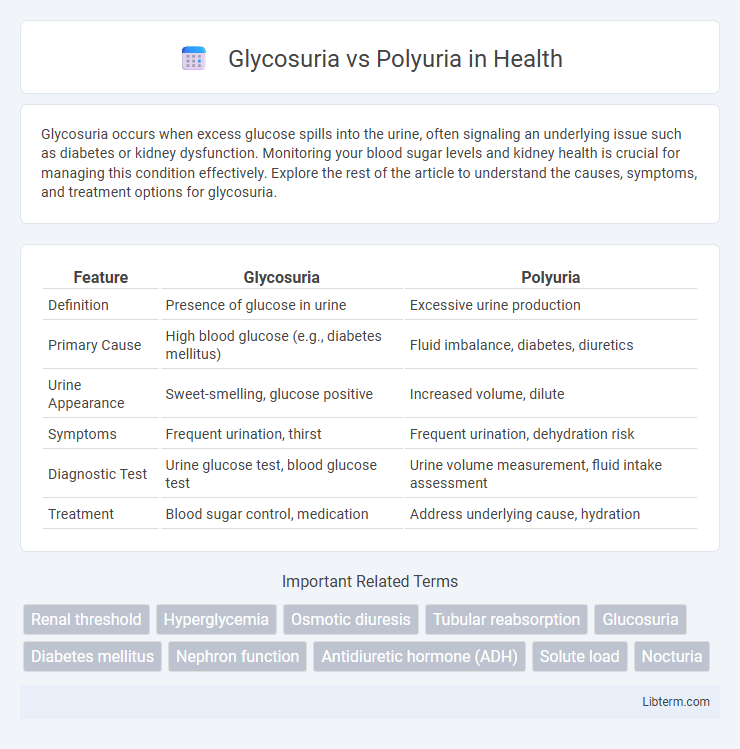Glycosuria occurs when excess glucose spills into the urine, often signaling an underlying issue such as diabetes or kidney dysfunction. Monitoring your blood sugar levels and kidney health is crucial for managing this condition effectively. Explore the rest of the article to understand the causes, symptoms, and treatment options for glycosuria.
Table of Comparison
| Feature | Glycosuria | Polyuria |
|---|---|---|
| Definition | Presence of glucose in urine | Excessive urine production |
| Primary Cause | High blood glucose (e.g., diabetes mellitus) | Fluid imbalance, diabetes, diuretics |
| Urine Appearance | Sweet-smelling, glucose positive | Increased volume, dilute |
| Symptoms | Frequent urination, thirst | Frequent urination, dehydration risk |
| Diagnostic Test | Urine glucose test, blood glucose test | Urine volume measurement, fluid intake assessment |
| Treatment | Blood sugar control, medication | Address underlying cause, hydration |
Introduction to Glycosuria and Polyuria
Glycosuria is the presence of glucose in the urine, often indicating elevated blood sugar levels commonly associated with diabetes mellitus. Polyuria refers to the excessive production and passage of urine, frequently resulting from conditions such as diabetes insipidus or uncontrolled diabetes mellitus. Both glycosuria and polyuria serve as important clinical signs that aid in diagnosing and managing metabolic and renal disorders.
Defining Glycosuria: Causes and Mechanisms
Glycosuria occurs when glucose is present in the urine, typically caused by high blood glucose levels exceeding the renal threshold, often seen in uncontrolled diabetes mellitus. The kidneys normally reabsorb glucose, but hyperglycemia leads to saturation of glucose transporters in renal tubules, resulting in glucose spilling into the urine. Polyuria, characterized by excessive urine production, frequently accompanies glycosuria as osmotic diuresis drives increased fluid excretion due to glucose retention in the renal tubules.
Understanding Polyuria: Key Concepts
Polyuria is characterized by excessive urine output exceeding 3 liters per day, often resulting from an osmotic diuresis caused by elevated blood glucose levels in conditions such as diabetes mellitus. Glycosuria, the presence of glucose in urine, directly contributes to polyuria by drawing excess water into the urine due to glucose's osmotic effect. Understanding the pathophysiology of polyuria involves recognizing how hyperglycemia-induced glycosuria leads to fluid imbalance, dehydration, and electrolyte disturbances.
Glycosuria vs Polyuria: Major Differences
Glycosuria refers to the presence of glucose in the urine, typically caused by high blood sugar levels exceeding the renal threshold, often seen in uncontrolled diabetes mellitus. Polyuria is characterized by excessive urination volume, which may result from osmotic diuresis due to glycosuria or other conditions like diabetes insipidus. The major difference lies in glycosuria indicating glucose excretion, whereas polyuria describes increased urine output regardless of its composition.
Common Causes of Glycosuria
Glycosuria commonly results from elevated blood glucose levels due to uncontrolled diabetes mellitus, where excess glucose surpasses renal tubular reabsorption capacity. Other causes include renal glycosuria, a benign condition caused by mutations affecting glucose transporters in the kidneys, and pregnancy-induced changes in renal threshold for glucose. Polyuria, often seen in diabetes insipidus or as a symptom of osmotic diuresis in hyperglycemia, involves increased urine volume but differs mechanistically from glycosuria's glucose presence in urine.
Typical Causes of Polyuria
Polyuria is commonly caused by diabetes mellitus, where high blood glucose levels lead to osmotic diuresis, resulting in excessive urine production. Other typical causes include diabetes insipidus, characterized by impaired antidiuretic hormone function, and excess fluid intake or diuretics use. Glycosuria, specifically, occurs when glucose exceeds renal threshold and spills into urine, often accompanying polyuria in diabetes mellitus.
Symptoms: Glycosuria vs Polyuria
Glycosuria symptoms primarily include the presence of glucose in the urine, often detected through urinalysis, without necessarily causing increased urine volume. Polyuria is characterized by excessive urination, typically exceeding 3 liters per day in adults, and is often accompanied by dehydration and increased thirst. While glycosuria indicates abnormal glucose filtration due to hyperglycemia or renal threshold issues, polyuria signals a disturbance in fluid balance often linked to diabetes mellitus, diabetes insipidus, or kidney disorders.
Diagnostic Approaches for Glycosuria and Polyuria
Diagnostic approaches for glycosuria primarily involve urinalysis to detect the presence of glucose in the urine, often complemented by blood glucose testing including fasting plasma glucose and oral glucose tolerance tests to confirm hyperglycemia associated with diabetes mellitus. In contrast, polyuria diagnosis focuses on measuring urine volume over 24 hours, assessing serum electrolytes and osmolality, and conducting water deprivation tests to differentiate between causes such as diabetes insipidus or uncontrolled diabetes mellitus. Advanced diagnostics may include renal function tests and imaging studies when an underlying renal or endocrine disorder is suspected in patients presenting with either glycosuria or polyuria.
Treatment Options for Each Condition
Treatment options for glycosuria primarily involve managing the underlying cause, most commonly diabetes mellitus, through insulin therapy, oral hypoglycemic agents, and lifestyle modifications including diet and exercise to control blood glucose levels. Polyuria treatment targets the root cause such as diabetes insipidus, which may require desmopressin to replace antidiuretic hormone, or addressing other conditions like uncontrolled diabetes mellitus through fluid replacement and blood sugar regulation. Both conditions demand careful monitoring of electrolyte balance and hydration status to prevent complications.
Prevention and Long-Term Management
Effective prevention of glycosuria involves maintaining stable blood glucose levels through a balanced diet, regular exercise, and consistent monitoring for individuals with diabetes. Long-term management of polyuria requires addressing underlying causes such as diabetes or kidney disorders, alongside hydration regulation and medication adherence. Both conditions benefit from routine medical evaluations to prevent complications and ensure optimal metabolic control.
Glycosuria Infographic

 libterm.com
libterm.com